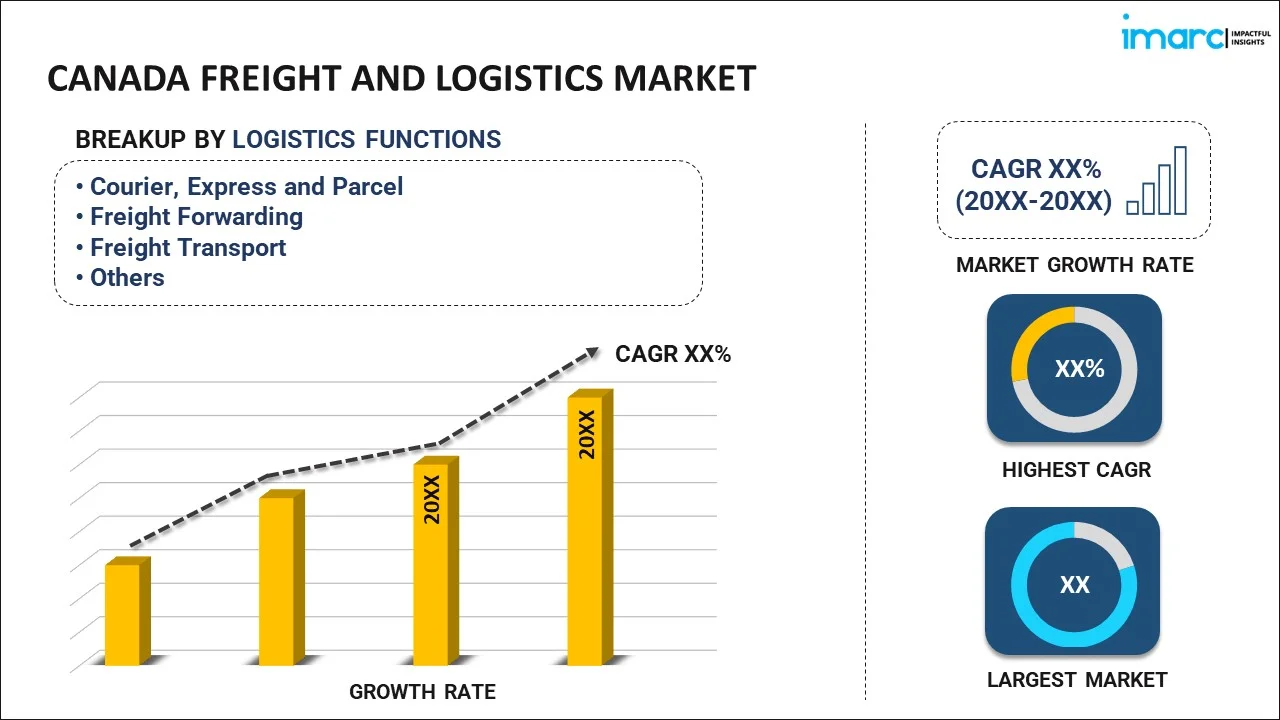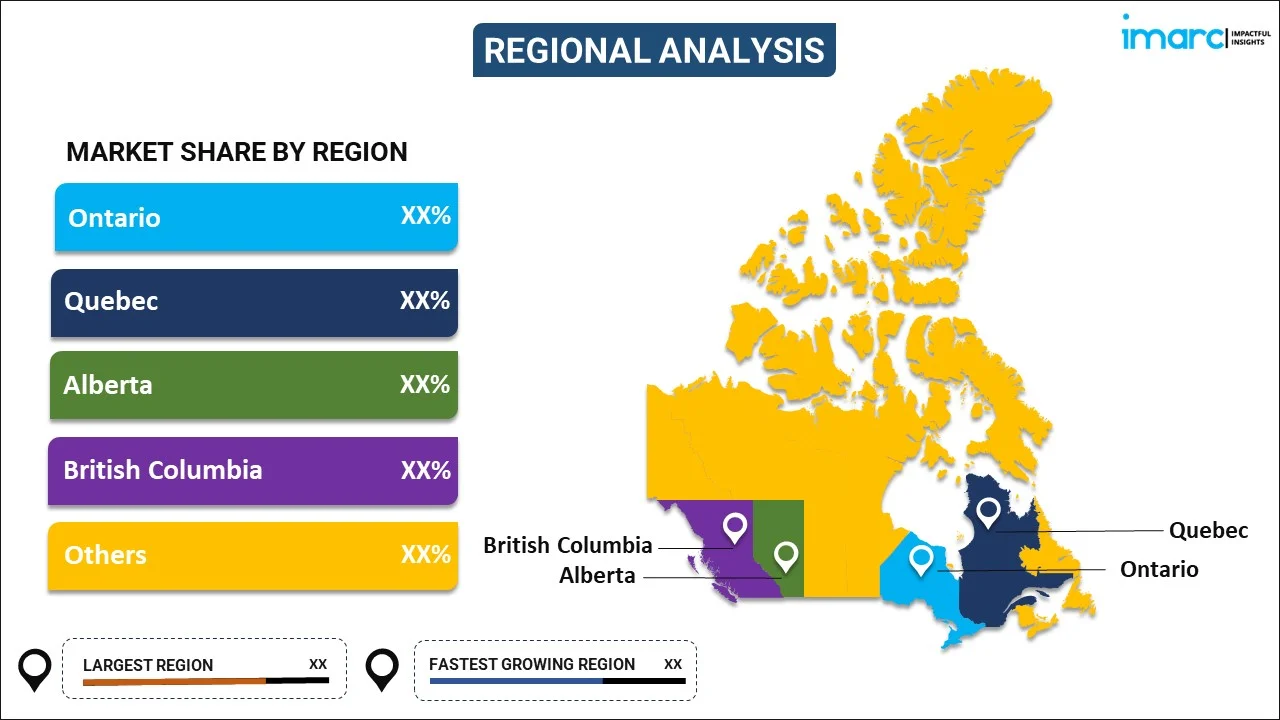
Canada Freight and Logistics Market Report by Logistics Function (Courier, Express and Parcel, Freight Forwarding, Freight Transport, Warehousing and Storage, and Others), End Use Industry (Agriculture, Fishing and Forestry, Construction, Manufacturing, Oil and Gas, Mining and Quarrying, Wholesale and Retail Trade, and Others), and Region 2024-2032
Canada Freight and Logistics Market Overview:
The Canada freight and logistics market size reached US$ 2.1 Trillion in 2023. Looking forward, IMARC Group expects the market to reach US$ 3.4 Trillion by 2032, exhibiting a growth rate (CAGR) of 5.30% during 2024-2032. The market is experiencing robust growth driven by e-commerce expansion, significant government infrastructure investments, and technological advancements. Enhanced real-time tracking, route optimization, and increased capacity for efficient freight handling are key trends shaping the market, ensuring improved operational efficiency and customer satisfaction.
|
Report Attribute
|
Key Statistics
|
|---|---|
|
Base Year
|
2023 |
|
Forecast Years
|
2024-2032 |
|
Historical Years
|
2018-2023
|
| Market Size in 2023 | US$ 2.1 Trillion |
| Market Forecast in 2032 | US$ 3.4 Trillion |
| Market Growth Rate (2024-2032) | 5.30% |
Canada Freight and Logistics Market Trends:
Rise of E-Commerce Market
The rise of ecommerce has significantly transformed the logistics sector in Canada with online retail sales becoming one of the major market components. This growth is driven by the rising consumer preference for online shopping, facilitated further by the COVID-19 pandemic. According to an article by the International Trade Administration, in Canada over 27 million people used ecommerce platforms in 2022 which is almost 75% of the total population, this number is expected to grow to 77.6% by 2025. Retail ecommerce sales Canada reached 3.82 billion USD in December 2020 with estimates of reaching 40.3 billion USD by 2025. Electronics is a leading category followed by fashion and furniture. Credit cards are used by 59% of Canadian online shoppers while digital wallets are estimated to account for 27% of online payments by 2025. As a result, logistics providers are facing higher freight volumes and need for faster more efficient delivery solutions. To meet these demands companies nowadays are investing in advanced technologies like automated warehouses, real time tracking systems and robust last mile delivery networks. This shift not only improves operational efficiency but also enhances consumer satisfaction by ensuring timely and accurate deliveries. The ecommerce boom is thus reshaping the logistics landscape prompting a revaluation of supply chain strategies to accommodate the rising demand.
Technological Advancements
The integration of advanced technologies such as artificial intelligence (AI) and machine learning (ML) is revolutionizing the freight management industry in Canada. For instance, in February 2024, C.H. Robinson revolutionized the freight industry by introducing touchless appointment technology, automating the process of scheduling pick-up and delivery appointments. This innovation, driven by extensive data and artificial intelligence, is saving shippers time and money while speeding up the shipping process. With touchless appointments completed in less than 2 minutes, shippers and carriers benefit from increased efficiency and reduced costs, marking a significant advancement for the logistics industry. These technologies enhance real time tracking which further provides precise visibility of shipments throughout the supply chain. AI and ML algorithms optimize routes by analyzing vast amount of data including traffic patterns, weather conditions and delivery schedules ensuring the most efficient and cost-effective paths are chosen. This optimization reduces fuel consumption and operational cost while improving delivery speed and reliability. In line with this, predictive analytics powered by AI can forecast demand fluctuations allowing logistics companies to adjust their capacities proactively. Automation of warehousing operations through robotics and AI driven systems enhances inventory management, order picking and packaging processes which in turn boost the productivity and accuracy. These technological advancements are important for maintaining competitiveness and rapidly evolving market. They enable logistics providers to meet growing consumer expectations of faster, reliable and transparent services.
Canada Freight and Logistics Market News:
- In January 2024, Syngenta Canada partnered with Future Transfer to introduce electric trucks to its logistics transportation fleet, aiming to achieve zero CO2e emissions in 2024. This move makes Syngenta the first agricultural company in Canada to adopt electric trucks for product delivery, reducing CO2e emissions by approximately 25,000 kilograms annually. The company plans to debut three electric trucks in southern Ontario this year, with the initiative expected to contribute to 38% global emissions reduction by 2030.
- In January 2024, Roadrunner, a leading transportation company, announced its largest LTL expansion in five years. The expansion includes the addition of 135 new lanes to its network, as well as the introduction of new services to Canada and Portland. This expansion aligns with Roadrunner's strategy to provide premium LTL long-haul carrier service.
Canada Freight and Logistics Market Segmentation:
IMARC Group provides an analysis of the key trends in each segment of the market, along with forecasts at the country level for 2024-2032. Our report has categorized the market based on logistics function and end use industry.
Logistics Function Insights:

- Courier, Express and Parcel
- By Destination Type
- Domestic
- International
- By Destination Type
- Freight Forwarding
- By Mode of Transport
- Air
- Sea and Inland Waterways
- Others
- By Mode of Transport
- Freight Transport
- By Mode of Transport
- Air
- Pipelines
- Rail
- Road
- Sea and Inland Waterways
- By Mode of Transport
- Warehousing and Storage
- By Temperature Control
- Non-Temperature Controlled
- Temperature Controlled
- By Temperature Control
- Others
The report has provided a detailed breakup and analysis of the market based on the logistics function. This includes courier, express and parcel [by destination type (domestic and international)], freight forwarding [by mode of transport (air, sea and inland waterways, and others)], freight transport [by mode of transport (air, pipelines, rail, road, and sea and inland waterways)], warehousing and storage [by temperature control (non-temperature controlled and temperature controlled)], and others.
End Use Industry Insights:
- Agriculture, Fishing and Forestry
- Construction
- Manufacturing
- Oil and Gas
- Mining and Quarrying
- Wholesale and Retail Trade
- Others
A detailed breakup and analysis of the market based on the end use industry have also been provided in the report. This includes agriculture, fishing and forestry, construction, manufacturing, oil and gas, mining and quarrying, wholesale and retail trade, and others.
Regional Insights:

- Ontario
- Quebec
- Alberta
- British Columbia
- Others
The report has also provided a comprehensive analysis of all the major regional markets, which include Ontario, Quebec, Alberta, British Columbia, and others.
Competitive Landscape:
The market research report has also provided a comprehensive analysis of the competitive landscape in the market. Competitive analysis such as market structure, key player positioning, top winning strategies, competitive dashboard, and company evaluation quadrant has been covered in the report. Also, detailed profiles of all major companies have been provided.
Canada Freight and Logistics Market Report Coverage:
| Report Features | Details |
|---|---|
| Base Year of the Analysis | 2023 |
| Historical Period | 2018-2023 |
| Forecast Period | 2024-2032 |
| Units | US$ Trillion |
| Scope of the Report | Exploration of Historical Trends and Market Outlook, Industry Catalysts and Challenges, Segment-Wise Historical and Future Market Assessment:
|
| Logistics Functions Covered |
|
| End Use Industries Covered | Agriculture, Fishing and Forestry, Construction, Manufacturing, Oil and Gas, Mining and Quarrying, Wholesale and Retail Trade, Others |
| Regions Covered | Ontario, Quebec, Alberta, British Columbia, Others |
| Customization Scope | 10% Free Customization |
| Post-Sale Analyst Support | 10-12 Weeks |
| Delivery Format | PDF and Excel through Email (We can also provide the editable version of the report in PPT/Word format on special request) |
Key Questions Answered in This Report:
- How has the Canada freight and logistics market performed so far and how will it perform in the coming years?
- What has been the impact of COVID-19 on the Canada freight and logistics market?
- What is the breakup of the Canada freight and logistics market on the basis of logistics function?
- What is the breakup of the Canada freight and logistics market on the basis of end use industry?
- What are the various stages in the value chai of the Canada freight and logistics market?
- What are the key driving factors and challenges in the Canada freight and logistics?
- What is the structure of the Canada freight and logistics market and who are the key players?
- What is the degree of competition in the Canada freight and logistics market?
Key Benefits for Stakeholders:
- IMARC’s industry report offers a comprehensive quantitative analysis of various market segments, historical and current market trends, market forecasts, and dynamics of the Canada freight and logistics market from 2018-2032.
- The research report provides the latest information on the market drivers, challenges, and opportunities in the Canada freight and logistics market.
- Porter's five forces analysis assist stakeholders in assessing the impact of new entrants, competitive rivalry, supplier power, buyer power, and the threat of substitution. It helps stakeholders to analyze the level of competition within the Canada freight and logistics industry and its attractiveness.
- Competitive landscape allows stakeholders to understand their competitive environment and provides an insight into the current positions of key players in the market.
Need more help?
- Speak to our experienced analysts for insights on the current market scenarios.
- Include additional segments and countries to customize the report as per your requirement.
- Gain an unparalleled competitive advantage in your domain by understanding how to utilize the report and positively impacting your operations and revenue.
- For further assistance, please connect with our analysts.
 Inquire Before Buying
Inquire Before Buying
 Speak to an Analyst
Speak to an Analyst
 Request Brochure
Request Brochure
 Request Customization
Request Customization




.webp)




.webp)












